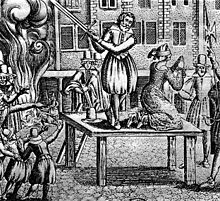Leonora Galigaï
Leonora Galigaï , also Leonora Dori or Leonora Dori Galigai (born May 19, 1568 in Florence , † July 8, 1617 in Paris ) was a foster sister and lady-in-waiting Maria de Medicis at the Tuscan and French courts.
Life
Her father was a carpenter and her mother was a wet nurse at the Medici court since the birth of Maria de Medici in April 1573 . In 1588 Leonora was appointed by Maria's uncle, Grand Duke Ferdinand I , as his nephew's maid. She remained in the service of Maria de Medici for almost thirty years, both during her time as the Tuscan princess and later after Maria became queen of France.
Initially only a foster sister, she became a friend and confidante of Maria von Medicis and, after the wedding, accompanied her by procurationem with the French King Henry IV in her entourage to Paris to the French court. Leonora had the title of socialite and chambermaid . In 1601 she married Concino Concini , a man of aristocracy from Arezzo in the suite of Mary. Her and her husband's influence on the queen grew, so that the king repeatedly threatened both of them with banishment if they did not change their behavior. After Henry IV's assassination, with some authors assuming that Concini was complicit if not authorship, his and Leonora's influence grew enormously. He bought the title of Marquis of Ancre (Marquis d'Ancre). He later took on the title of general and made himself Marshal of France , preferring to call himself " Maréchal d'Ancre". He became the most powerful man in France during the reign of Maria de Medici. From now on his wife Leonora was dubbed "Madame Maréchale d'Ancre". She de facto took over the business of government (nominal reign by the queen) of the underage son and successor of Henry IV., King Louis XIII. whose influence and power was gradually curtailed. Furthermore, through the influence of both, Tuscan followers were preferred in the awarding of honorary offices and privileges , while the power of the French nobility was weakened. Because Leonore suffered from epilepsy , she was very interested in occult practices and witchcraft in the hope of finding relief or cure for her disease, which was incurable at that time.
After the disempowerment and murder of her husband (April 24, 1617), Leonora Galigaï was arrested as a result of a palace conspiracy against the king and transferred to the Bastille . She could not hope for any help, not even from her powerful friend, the Queen Mother. At that time, robbed of its former power, it was under house arrest in the castle of Blois by order of the king . Leonora Galigai was accused of witchcraft and the practice of Jewish religion (French: juiverie ) and after a short trial was found guilty of " divine and human lese majesty " and sentenced to " death by cutting off the head and burning the body parts to ashes" at the stake . When asked by her judges how she could succeed in influencing Maria de Medici, she replied: “My art of seduction sets those with a strong soul over weak spirits.” (“Mon charme fut celui des âmes fortes sur les esprits faibles”). On July 8, the judgment was carried out on the Place de Grève (today Place de l'Hôtel-de-Ville) in Paris with a large crowd . She is said to have approached her death with dignity.
The Marshal d'Ancre in literature
Voltaire recalls the cremation of the Marschallin d'Ancre, which is an astonishing and unforgettable memorial to the superstition that determined French politics before the Enlightenment and tore other innocent people, such as Urbain Grandier , to their ruin.
Web links
Individual evidence
- ↑ "On se souviendra avec étonnement, jusqu'à la dernière postérité, que la maréchale d'Ancre fut brûlée en place de Grève comme sorcière" Voltaire: Le Siècle de Louis XIV Édition établie et annotee par René Pomeau et revue par Nicholas. Cronk, Paris: Édtion Gallimard, 2015, p.
| personal data | |
|---|---|
| SURNAME | Galigaï, Leonora |
| ALTERNATIVE NAMES | Dori Galigai, Leonora; Dori, Leonora; Concini, Leonora |
| BRIEF DESCRIPTION | French court lady and regent of Tuscan origin |
| DATE OF BIRTH | May 19, 1568 |
| PLACE OF BIRTH | Florence |
| DATE OF DEATH | July 8, 1617 |
| Place of death | Paris |


